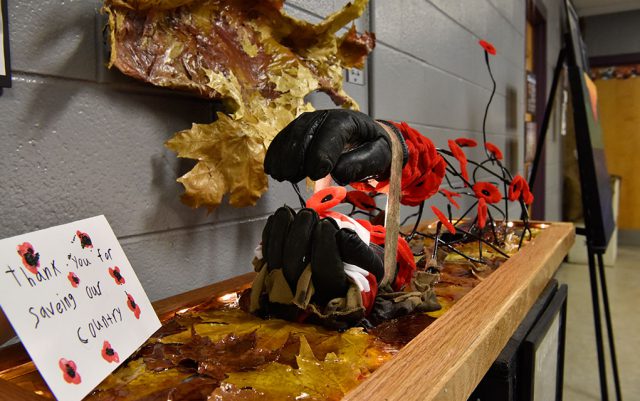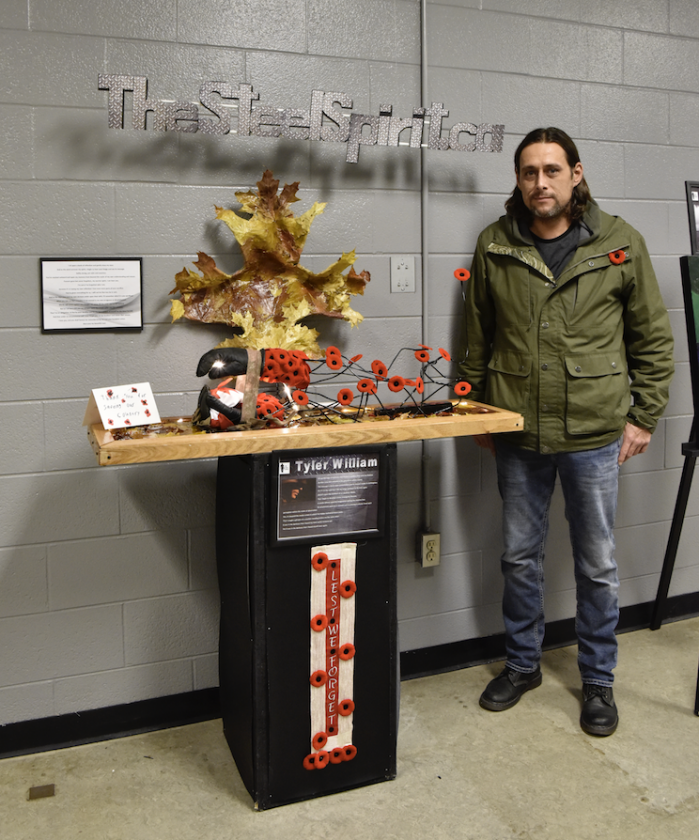
Interview with Artist, Tyler William Shepperdson who sheds light on the emotions behind the art.

Shepperdson began the interview by walking me through the meaning behind his sculpture, entitled Reflections, which was on display as part of the Steel Spirit Gallery at CFB Borden, 4-8 November.
Originally, when Shepperdson began creating the piece, it was going to be an abstract oil painting on canvas with a, “single hand reaching out of the painting to present a poppy to all of us.” In Shepperdson’s mind, the sculpted hand was to be that of a soldier, and the piece was to be crafted with Remembrance Day in mind. Shepperdson quickly changed his design for the piece saying, “Our brave men and women have already given enough.”
The passion Shepperdson has for Remembrance Day is very personal in nature as he spent time serving with the CAF. A Veteran, Shepperdson was medically released from the military while a Corporal. Following this, a series of extreme and unforeseen circumstances led him to lose his foundation, “there was a time when I was actually homeless,” said Shepperdson. He opened up, telling me he did not see it coming, but that, “it happened, and at the end of it all, I didn’t know who I could turn to – I was pretty much all I had.” Shepperdson continued, “I turned to VETS Canada. Without question, or hesitation, they helped me tremendously – may have even saved me.” In addition to this, Shepperdson spoke of the help extended to him by Quilts of Valour and his local Legion in Orillia, “people have been there when I least expected them.”
Shepperdson wanted to pay that meaning forward with his art. He thus devised a way of honouring the fallen and the sacrifices of those who have served, while simultaneously portraying his own experiences.
The 158 individually picked and trimmed maple leaves at the sculpture’s base represent the fallen, with a loose layer of maple leaves resting atop to represent the people and organizations who have helped Shepperdson along his way. He placed these to metaphorically offer warmth and comfort. At the same time, Shepperdson hopes to, “pay respect to the ones who remember, and the ones who are still here struggling.”
One unique feature of the sculpture is the utilization of artificial poppies as a centre aspect. The poppies commemorate many different ideas. The “spirit hands,” with poppies flowing out of the gloves, are looked over by a handmade maple leaf, constructed of many smaller leaves, symbolizing the Canadian flag and the people who make up our country.
“That’s my way of saying we may have lost you, but you’re still with us, you’re still here in our hands, in our hearts, and in our minds,” said Shepperdson. “We protect their sacrifice through remembrance.” This is why the poppies drift from the gloves — to represent the legacy left behind for us to carry. It is also why the two gloves are cuffed together with fabric. These are to say that such a sacrifice is “forever bound in blood and loss.”
A single poppy stands out, resting above the others. This particular poppy, Shepperdson explained, is for those lost to suicide.
“When you think of traditional remembrance,” he said, “you think of the battles fought, the battles encountered while facing those atrocities – you don’t think of the ones we lose to mental health and the demons and the scars afterword.” Through his art, Shepperdson helps to remind us that remembrance is for wars, remembrance is for conflicts, and remembrance is for those at home.
A second feature, adding to the complexity of the piece, is the multiple elevens hidden within the piece. These represent 11/11/11, the date on which we observe Armistice Day. The base plank measures 11 in by 111 cm, providing the first two elevens. The last 11 comes from the individuality of the sculpture. It is “one of one,” which, according to Shepperdson, “signifies everyone who is here now – as a singular entity.”
Lastly, the artist included a card given to him by the children at Harriett Todd Public School in Orillia. It reads, “Thank you for saving our country.”
“This is what we fight for, what we protect,” emphasized Shepperdson, who believes that change begins with our youth, and that their energy should thus be included in the piece.
“The beautiful thing about art is that you set out to do a project and it never finishes that way – it becomes its own energy,” said Shepperdson. “As I was building this, I wondered how I could incorporate everything into this display. Because of Remembrance Day coming up, I didn’t want to focus in on my own experience serving, but I didn’t want to negate that either, because that’s part of the art – you put yourself into it, right?”
As Shepperdson is, once again thriving, he will be donating the sculpture to the Legion in Orillia as a thank you for everything they have done for both him and the community as whole.
Entrevue avec l’artiste Tyler William Shepperdson qui nous éclaire sur les émotions derrière l’art.
M. Shepperdson a amorcé l’entrevue en m’expliquant la signification de sa sculpture, intitulée Reflections, qui a été exposée à la Galerie Steel Spirit de la BFC Borden, du 4 au 8 novembre.
À l’origine, lorsque M. Shepperdson a commencé à créer la pièce, il s’agissait d’une peinture à l’huile abstraite sur toile présentant une « main qui sortait de la toile pour présenter à l’observateur un coquelicot ». Dans l’esprit de M. Shepperdson, la main sculptée devait être celle d’un soldat, et la pièce devait être fabriquée en pensant au jour du Souvenir. Tyler a rapidement changé son concept pour la pièce, se disant : « Nos braves hommes et femmes en ont déjà assez donné ».
La passion de M. Shepperdson pour le jour du Souvenir est de nature très personnelle en raison du temps qu’il a passé au service des FAC. Ancien combattant, M. Shepperdson a été libéré de l’armée pour des raisons de santé alors qu’il était caporal. Par la suite, une série de circonstances extrêmes et imprévues l’ont conduit à perdre ses moyens, « il fut un temps où j’étais sans abri », a dit M. Shepperdson. Il se dévoila en me disant qu’il ne l’avait pas vu venir, mais que, « c’est arrivé, et en fin de compte, je ne savais pas vers qui me tourner – j’étais à peu près tout ce que j’avais ». M. Shepperdson a poursuivi : « Je me suis tourné vers VETS Canada. Sans question ni hésitation, ils m’ont aidé énormément – ils m’ont peut-être même sauvé. » De plus, M. Shepperdson a parlé de l’aide que lui ont apportée Quilts of Valour et la section locale de la Légion à Orillia. « Ces gens ont été là quand je m’y attendais le moins. »
M. Shepperdson voulait donner ce sens à son art. Il a ainsi conçu une façon d’honorer les personnes tombées au combat et les sacrifices de ceux qui ont servi, tout en décrivant ses propres expériences. Les 158 feuilles d’érable cueillies et taillées individuellement à la base de la sculpture représentent les personnes tombées au combat avec une couche flottante de feuilles d’érable reposant sur le tout pour représenter les gens et les organisations qui ont aidé M. Shepperdson sur son chemin. Il les a ainsi placées pour offrir métaphoriquement chaleur et confort. En même temps, M. Shepperdson espère « rendre hommage à ceux qui se souviennent et à ceux qui luttent encore ici ».
Une caractéristique unique de la sculpture est l’utilisation de coquelicots artificiels en son centre. Les coquelicots commémorent de nombreuses idées différentes. Une feuille d’érable fabriquée à la main à partir de nombreuses feuilles plus petites, symbolisant le drapeau canadien et les gens qui composent notre pays, surplombe les « mains spirituelles », tandis que des coquelicots ressortent des gants. « C’est ma façon de dire que nous vous avons peut-être perdus, mais vous êtes toujours avec nous, vous êtes toujours là entre nos mains, dans nos cœurs et dans nos esprits », a dit M. Shepperdson. « Nous protégeons leur sacrifice par le souvenir. » C’est pourquoi les coquelicots glissent des gants pour représenter l’héritage que nous laissons derrière nous. C’est aussi la raison pour laquelle les deux gants sont menottés ensemble avec du tissu. C’est-à-dire qu’un tel sacrifice est « à jamais lié par le sang et la perte ».
Un seul coquelicot se détache du lot, reposant au-dessus des autres. Ce coquelicot en particulier, a expliqué M. Shepperdson, est destiné aux personnes décédées par suicide.
« Quand vous pensez au souvenir traditionnel, dit-il, vous pensez aux batailles livrées, aux batailles que nous avons vécues face à ces atrocités – vous ne pensez pas à celles que nous perdons à cause de la santé mentale, des démons et des cicatrices qui suivent. » Par son art, M. Shepperdson nous rappelle que le souvenir, c’est pour la guerre, le souvenir, c’est pour les conflits et le souvenir, c’est pour ceux qui restent au pays.
Une deuxième caractéristique, qui ajoute à la complexité de la pièce, est la multiplicité de onze cachés à l’intérieur de la pièce. Ils représentent le 11/11/11, date à laquelle nous célébrons le jour de l’Armistice. La plaque de base mesure 11 po sur 111 cm, fournissant les deux premiers onze. Les autres 11 cachés se dissimulent dans l’individualité de la sculpture. Il s’agit « d’une œuvre d’unicité », ce qui, selon Shepperdson, « signifie tous ceux qui sont ici maintenant – comme une entité distincte ».
Enfin, l’artiste a inclus à l’œuvre une carte qui lui a été remise par les enfants de l’école publique Harriett Todd à Orillia. On peut y lire : « Merci d’avoir sauvé notre pays ».
« C’est pour cela que nous nous battons, c’est pour cela que nous protégeons », a souligné M. Shepperdson, qui croit que le changement commence avec notre jeunesse, et que leur énergie devait donc être incluse dans la pièce.
« Ce qu’il y a de beau dans l’art, c’est qu’on entreprend un projet et qu’il ne se termine jamais comme on s’y attendait – il acquiert sa propre énergie », dit M. Shepperdson. « Alors que je créais cette œuvre, je me suis demandé comment je parviendrais à tout intégrer ce que je souhaitais intégrer. À l’approche du jour du Souvenir, je ne voulais pas me concentrer sur ma propre expérience de service, mais je ne voulais pas nier cela non plus, parce que ça fait partie de l’art – l’artiste doit s’intégrer dans l’œuvre, n’est-ce pas? »
Comme M. Shepperdson a trouvé un nouveau souffle dans la vie, il fera don de sa sculpture à la Légion d’Orillia en guise de remerciement pour tout ce qu’ils ont fait pour lui et la collectivité dans son ensemble.
By/Par: Zoe Côté











